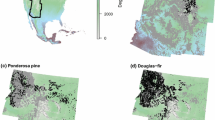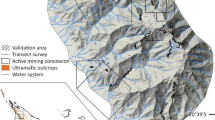Abstract
Context
Land-use legacies play an important role in shaping contemporary species distributions. However, land-use legacies are rarely considered in species distribution models (SDMs) that aim to model present-day species distributions across the landscape, even though they can lead to a species absence in suitable areas. SDMs that do not account for land-use legacies will likely result in biased predictions of species distributions.
Objective
We examine the importance of land-use legacies for modeling present-day distributions of tree species at a regional scale, assessing how the addition of land-use legacy variables improves predictive power of SDMs.
Methods
We generated land-use legacy variables using raster layers of reconstructed historical agricultural land use and 3310 inventory plots. SDMs were developed for six forest tree species based on climatic, edaphic, and topographic variables, and with (SDMLU) and without (SDMBase) land-use legacy variables. We compared the predictive power between SDMLU and SDMBase models and then quantified the local importance of land-use legacy variables relative to other abiotic variables.
Results
Our results show that the importance of land-use legacy variables for present-day species distributions and the improvement on the predictive power of SDMs is species-specific. The inclusion of land-use legacy variables improved SDMs primarily by lowering errors of commission and increasing the overall accuracy of prediction.
Conclusion
The influence of land-use legacies on SDMs suggests that, for some tree species, incorporating land-use legacies can accurately identify suitable areas that are not occupied by the species due to land-use legacies, and advance our understanding of their present-day distributions.







Similar content being viewed by others
References
Abrams MD (1998) The red maple paradox. Bioscience 48(5):355–364
Abrams MD (2003) Where has all the white oak gone? Bioscience 53(10):927–939
Albright TA (2018) Forests of Pennsylvania, 2017 Resource Update FS-175 Newtown Square, PA: US. Department of Agriculture, Forest Service, Northern Research Station. 4 p. Doi: 10.2737/FS-RU-175
Bechtold WA, Patterson PL (2005) The Enhanced Forest Inventory and Analysis Program — National Sampling Design and Estimation Procedures. USDA Gen Tech Rep
Beers T, Dress P, Wensel L (1966) Notes and observations: aspect transformation in site productivity research. J For 64(10):691–692
Bellemare J, Motzkin G, Foster DR (2002) Legacies of the agricultural past in the forested present: An assessment of historical land-use effects on rich mesic forests. J Biogeogr 29(10–11):1401–1420
Black BA, Abrams MD (2001) Influences of Native Americans and surveyor biases on metes and bounds witness-tree distribution. Ecology. https://doi.org/10.1890/0012-9658(2001)082[2574:IONAAS]2.0.CO;2
Black BA, Ruffner CM, Abrams MD (2006) Native American influences on the forest composition of the Allegheny Plateau, northwest Pennsylvania. Can J For Res. https://doi.org/10.1139/X06-027
Breiman L (2001) Random forests. Mach Learn. https://doi.org/10.1023/A:1010933404324
Bürgi M, Östlund L, Mladenoff DJ (2017) Legacy effects of human land use: ecosystems as time-lagged systems. Ecosystems 20(1):94–103
Chen C, Liaw A, Breiman L (2004) Using random forest to learn imbalanced data. University of California, Berkeley
Compton JE, Boone RD (2000) Long-term impacts of agriculture on soil carbon and nitrogen in New England forests. Ecology 81(8):2314–2330
Cutler DR, Edwards TC, Beard KH et al (2007) Random forests for classification in ecology. Ecology. https://doi.org/10.1890/07-0539.1
DeCoster LA (1995) The legacy of Penn's Woods: a history of the Pennsylvania Bureau of Forestry. Pennsylvania Historical and Museum Commission for Department of Conservation and Natural Resources, Bureau of Forestry
Díaz-Uriarte R, De Andrés SA (2006) Gene selection and classification of microarray data using random forest. BMC Bioinformatics 7(1):3
Dyer JM (2010) Land-use legacies in a central Appalachian forest: differential response of trees and herbs to historic agricultural practices. Appl Veg Sci 13(2):195–206
Dubuis A, Giovanettina S, Pellissier L et al (2013) Improving the prediction of plant species distribution and community composition by adding edaphic to topo-climatic variables. J Veg Sci 24(4):593–606
Dupouey JL, Dambrine E, Laffite JD, Moares C (2002) Irreversible impact of past land use on forest soils and biodiversity. Ecology 83(11):2978–2984
Fielding AH, Bell JF (1997) A review of methods for the assessment of prediction errors in conservation presence/absence models. Environ Conserv 24(1):38–49
Flinn KM (2014) Agricultural legacies in forest herb communities. The Herbaceous Layer in Forests of Eastern North America. Oxford University Press, New York
Flinn KM, Vellend M (2005) Recovery of forest plant communities in post-agricultural landscapes. Front Ecol Environ 3(5):243–250
Foster DR (1992) Land-use history (1730–1990) and vegetation dynamics in Central New England, USA. J Ecol. https://doi.org/10.2307/2260864
Foster D, Swanson F, Aber J et al (2003) The importance of land-use legacies to ecology and conservation. Bioscience 53(1):77–88
Fraterrigo JM, Turner MG, Pearson SM (2006) Interactions between past land use, life-history traits and understory spatial heterogeneity. Landsc Ecol 21(5):777–790
Gehrig-Fasel J, Guisan A, Zimmermann NE (2007) Tree line shifts in the Swiss Alps: climate change or land abandonment? J Veg Sci 18(4):571–582
Glitzenstein JS, Canham CD, McDonnell MJ, Streng DR (1990) Glitzenstein JS, Canham CD, McDonnell MJ, Streng DR. Effects of environment and land-use history on upland forests of the Cary Arboretum, Hudson Valley, New York. Bull Torrey Bot Club 117(2):106–122
Goldewijk KK, Beusen A, Doelman J, Stehfest E (2017) Anthropogenic land use estimates for the Holocene - HYDE 3.2. Earth Syst Sci Data 9(2):927–953
Guisan A, Thuiller W (2005) Predicting species distribution: offering more than simple habitat models. Ecol Lett 8(9):993–1009
Hall B, Motzkin G, Foster DR et al (2002) Three hundred years of forest and land-use change in Massachusetts, USA. J Biogeogr 29(10–11):1319–1335
Hightower JN, Butterfield AC, Weishampel JF (2014) Quantifying ancient Maya land use legacy effects on contemporary rainforest canopy structure. Remote Sens 6(11):10716–10732
Horsley SB, Stout SL, DeCalesta DS (2003) White-tailed deer impact on the vegetation dynamics of a northern hardwood forest. Ecol Appl 13(1):98–118
Hosmer DW, Lemeshow S, Sturdivant RX (2013) Applied logistic regression: Third Edition. John Wiley & Sons
Iverson LR, Dale ME, Scott CT, Prasad A (1997) A GIS-derived integrated moisture index to predict forest composition and productivity of Ohio forests (USA). Landsc Ecol 12(5):331–348
Iverson LR, Prasad AM, Matthews SN, Peters M (2008) Estimating potential habitat for 134 eastern US tree species under six climate scenarios. For Ecol Manage 254(3):390–406
Jenness J, Majka D, Beier P (2013) Corridor Designer Evaluation Tools. https://corridordesign.org.
Latham RE, Beyea J, Benner M et al (2005) Managing white-tailed deer in forest habitat from an ecosystem perspective. In National Audubon Society Deer Management Forum, Harrisburg, Pennsylvania
Lavergne S, Mouquet N, Thuiller W, Ronce O (2010) Biodiversity and climate change: integrating evolutionary and ecological responses of species and communities. Annu Rev Ecol Evol Syst 41:321–350
Ledig FT, Rehfeldt GE, Sáenz-Romero C, Flores-López C (2010) Projections of suitable habitat for rare species under global warming scenarios. Am J Bot 97(6):970–987
Marquis DA (1975) The Allegheny hardwood forests of Pennsylvania. Gen. Tech. Rep. NE-15
McEwan RW, Dyer JM, Pederson N (2011) Multiple interacting ecosystem drivers: toward an encompassing hypothesis of oak forest dynamics across eastern North America. Ecography (Cop) 34(2):244–256
Mikan CJ, Orwig DA, Abrams MD (1994) Age structure and successional dynamics of a presettlement-origin chestnut oak forest in the Pennsylvania Piedmont. Bull Torrey Bot Club. https://doi.org/10.2307/2996880
Moisen GG, Freeman EA, Blackard JA et al (2006) Predicting tree species presence and basal area in Utah: a comparison of stochastic gradient boosting, generalized additive models, and tree-based methods. Ecol Modell 199(2):176–187
Nowacki GJ, Abrams MD (1992) Community, edaphic, and historical analysis of mixed oak forests of the Ridge and Valley Province, in central Pennsylvania. Can J For Res. https://doi.org/10.1139/x92-108
Nowacki GJ, Abrams MD (2015) Is climate an important driver of post-European vegetation change in the Eastern United States? Glob Chang Biol 21(1):314–334
Nyland RD (1999) Sugar maple: its characteristics and potentials. In: Horsley SB, Long RP, eds. Sugar maple ecology and health: proceedings of an international symposium; 1998 June 2–4; Warren, PA. Gen. Tech. Rep. NE-261. Radnor. PA: U.S. Department of Agriculture, Forest Service, Northern Research Station:1–13
O’Connell BM, Conkling BL, Wilson AM, et al (2017) The Forest Inventory and Analysis Database: Databased Description and User Guide for Phase 2 (version 7.0). US Department of Agriculture, Forest Service
Pearson RG, Dawson TP (2003) Predicting the impacts of climate change on the distribution of species: are bioclimate envelope models useful? Glob Ecol Biogeogr 12(5):361–371
Pearson RG, Dawson TP, Berry PM, Harrison PA (2002) SPECIES: a spatial evaluation of climate impact on the envelope of species. Ecol Modell 154(3):289–300
Pederson N, D’Amato AW, Dyer JM et al (2015) Climate remains an important driver of post-European vegetation change in the eastern United States. Glob Chang Biol 21(6):2105–2110
Peroni PA (1994) Invasion of red maple (Acer rubrum L.) during old field succession in the North Carolina Piedmont: age structure of red maple in young pine stands. Bull Torrey Bot Club 121(4):357–359
Prasad AM, Iverson LR, Liaw A (2006) Newer classification and regression tree techniques: bagging and random forests for ecological prediction. Ecosystems 9(2):181–199
Prasad AM, Iverson LR, Matthews S., Peters M (2007-ongoing) A climate change atlas for 134 forest tree species of the eastern United States [database]. Retrieved from US Department of Agriculture, Forest Service website: https://www.nrs.fs.fed.us/atlas/tree
R Development Core Team (2019) R: A language and environment for statistical computing, version 3.6.1. Vienna, Austria: R Foundation for Statistical Computing. URL https://www.R-project.org
Rehfeldt GE (2006) A spline model of climate for the Western United States. USDA For Serv Gen Tech Rep RMRS-GTR-165. https://doi.org/https://doi.org/10.2737/RMRS-GTR-165
Rehfeldt GE, Crookston NL, Warwell MV, Evans JS (2006) Empirical analyses of plant-climate relationships for the Western United States. Int J Plant Sci 167(6):1123–1150
Riemann R, Wilson BT, Lister AJ et al (2018) Tree species distribution in the United States Part 1. J MAPS 14(2):561–566
Riley SJ, DeGloria SD, Elliot R (1999) Index that quantifies topographic heterogeneity. Intermt J Sci 5(1–4):23–27
Soil Survey Staff (2014). Gridded Soil Survey Geographic (gSSURGO) Database for Pennsylvania. United States Department of Agriculture, Natural Resources Conservation Service. Available online at https://gdg.sc.egov.usda.gov
Strobl C, Zeileis A (2008). Danger: High power–exploring the statistical properties of a test for random forest variable importance. Proceedings of the 18th International Conference on Computational Statistics, Porto, Portugal
Strobl C, Boulesteix AL, Kneib T et al (2008) Conditional variable importance for random forests. BMC Bioinformatics 9(1):307
Walters RS, Yawney HW (1990) Acer rubrum L. Red maple. Silvics of North America 2:60–69
Walthert L, Meier ES (2017) Tree species distribution in temperate forests is more influenced by soil than by climate. Ecol Evol 7(22):9473–9484
Weiss AD (2001) Topographic position and landforms analysis (Poster). San Diego, CA: ESRI User Conference. https://www.jennessent.com/downloads/TPI-poster-TNC_18x22.pdf
Whitney, GG (1999) Sugar maple: abundance and site relationship in the pre- and post-settlement forest. In: Horsley SB, Long RP, eds. Sugar maple ecology and health: proceedings of an international symposium; 1998 June 2–4; Warren, PA. Gen. Tech. Rep. NE-261. Radnor. PA: U.S. Department of Agriculture, Forest Service, Northern Research Station: 14–118.
Yu Z, Lu C (2018) Historical cropland expansion and abandonment in the continental U.S. during 1850 to 2016. Glob Ecol Biogeogr 27(3):322–333
Zimmermann NE, Edwards TC, Graham CH et al (2010) New trends in species distribution modelling. Ecography (Cop) 33(6):985–989
Acknowledgements
We thank R. McCullough from the USDA Forest Service for providing soil and topography values for FIA plots. We also thank D. Diefenbach, E. Hanks, A. Prasad, and E. Smithwick who served in X. Chen’s dissertation committee for helpful comments. L. Leites acknowledges partial funding by the USDA National Institute of Food and Agriculture and Hatch Appropriations under Project #PEN04700 and Accession #1019151.
Author information
Authors and Affiliations
Corresponding author
Additional information
Publisher's Note
Springer Nature remains neutral with regard to jurisdictional claims in published maps and institutional affiliations.
Electronic supplementary material
Below is the link to the electronic supplementary material.
Rights and permissions
About this article
Cite this article
Chen, X., Leites, L. The importance of land-use legacies for modeling present-day species distributions. Landscape Ecol 35, 2759–2775 (2020). https://doi.org/10.1007/s10980-020-01119-0
Received:
Accepted:
Published:
Issue Date:
DOI: https://doi.org/10.1007/s10980-020-01119-0




